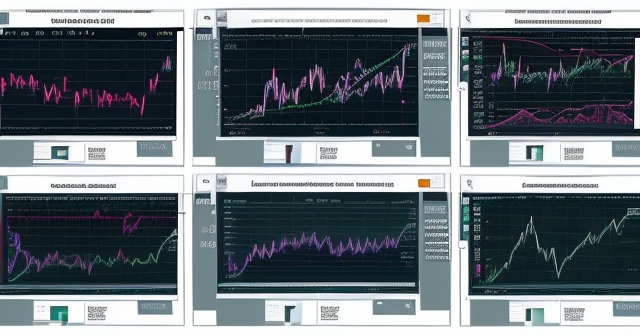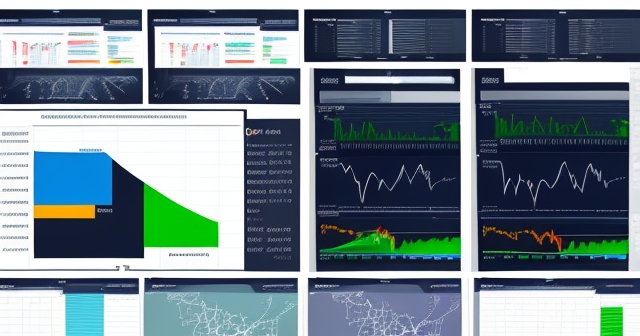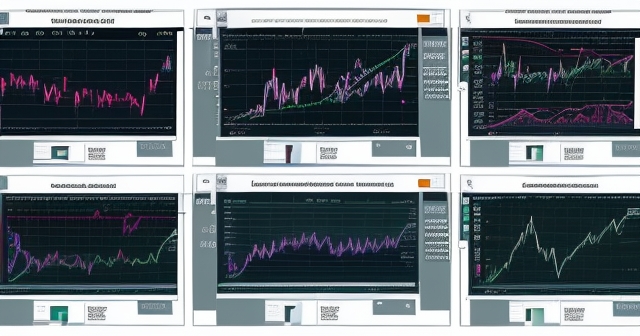Introducing USIG: Your Guide to the iShares Broad USD Investment Grade Corporate Bond ETF
Welcome to this detailed exploration of a significant player in the fixed income market: the iShares Broad USD Investment Grade Corporate Bond ETF, commonly known by its ticker symbol, USIG. As investors, you’re likely seeking ways to diversify your portfolio beyond stocks, aiming for potentially lower volatility and a consistent income stream. Corporate bonds, particularly those deemed “investment grade,” often fit this objective.
Think of investing as building a robust financial structure. While stocks might be the dynamic upper floors, fixed income like corporate bonds provides essential stability and foundation. USIG is designed to give you broad exposure to the U.S. dollar-denominated investment grade corporate bond market. It’s a popular choice for many, from those just starting to build a diversified portfolio to experienced traders looking to fine-tune their fixed income allocation.
In this guide, we’ll take a deep dive into USIG, breaking down its key characteristics, understanding the data points that define it, and discussing how it might fit into your overall investment strategy. We aim to provide you with the knowledge to understand this ETF not just as a ticker symbol, but as a sophisticated financial instrument representing a vast market segment.

Here are some key features to consider about USIG:
- Targets investment-grade corporate bonds to mitigate risk.
- Designed for both novice and experienced investors.
- Aims to provide consistent income and portfolio stability.
Understanding USIG’s Footprint: Assets, Volume, and Market Presence
One of the first things we often look at when considering an ETF is its size and how actively it trades. These factors give us insights into the fund’s liquidity and overall market acceptance. For USIG, the numbers tell a story of a large and well-established fund.
As of June 05, 2025, USIG boasted substantial Net Assets totaling over $13.75 billion ($13,755,284,554 to be precise). What does this massive figure tell us? Primarily, it indicates that the fund is widely held and trusted by a large number of investors. Funds with significant assets under management (AUM) are generally more liquid. This means it’s typically easier and faster to buy or sell shares of the ETF on the open market without significantly impacting its price.
Related to this is the fund’s trading volume. While the provided data gives a snapshot of a specific day’s activity, looking at the 30 Day Avg. Volume gives a clearer picture of its typical trading activity. High average volume suggests that there are many buyers and sellers actively trading the ETF shares throughout the day, further enhancing its liquidity. This is important for investors who might need to enter or exit positions quickly.
The fund’s Closing Price on any given day is determined by supply and demand on the exchange, much like a stock. However, because ETFs are open-ended funds, market makers can create or redeem shares directly with the fund sponsor (BlackRock, in this case) if the market price deviates significantly from the fund’s underlying Net Asset Value (NAV). This mechanism helps keep the ETF’s market price closely aligned with the value of the bonds it holds, a concept known as trading at a small Premium/Discount to NAV (USIG was trading at a slight discount of -0.07 as of June 05, 2025).
Understanding the scale and liquidity of an ETF like USIG is the first step in appreciating its role in the market. It’s not a niche or small fund; it’s a major vehicle for accessing the investment grade corporate bond universe.

Delving into Yield: How USIG Generates Income for Investors
For many investors considering fixed income, income generation is a primary objective. Bonds pay interest, and bond ETFs distribute that interest to shareholders. But there are different ways to measure yield, and it’s important to understand what each metric represents for USIG.
Let’s look at the key yield figures provided. The 30 Day SEC Yield was 5.26% as of June 04, 2025. This is a standardized yield calculation mandated by the U.S. Securities and Exchange Commission (SEC). It represents the income an investor would receive over the next 12 months if the fund’s portfolio remained unchanged and the income was reinvested. Think of it as a forward-looking estimate of the fund’s yield based on its recent income distribution rate, annualized and adjusted for fund expenses.
Another crucial yield metric is the Average Yield to Maturity (YTM), which was 5.20% as of June 05, 2025. The YTM is the total return anticipated on a bond if the bond is held until it matures. It considers the bond’s current market price, its par value, its coupon interest rate, and the time to maturity. For a portfolio like USIG, the Average YTM is the weighted average of the YTMs of all the bonds in the fund. It represents the potential average annual return if all the bonds were held until they matured and all interest payments were made as scheduled. YTM is a powerful concept because it accounts for both the interest payments and any capital gain or loss from buying a bond at a discount or premium to its par value.
The Weighted Avg Coupon (4.16% as of May 31, 2025) tells us the average interest rate paid by the bonds held in the portfolio. This is less dynamic than SEC Yield or YTM as it simply averages the stated coupon rates of the underlying bonds, weighted by their market value.
Why is it important to look at both SEC Yield and YTM? SEC Yield is often seen as a more stable measure of current income potential, reflecting recent distributions. YTM gives you a better sense of the total return potential if you held the *entire portfolio* through maturity, factoring in current prices. For USIG, these figures are close (5.26% and 5.20%), suggesting the current market prices relative to par values aren’t dramatically skewing the overall yield picture.
These yield metrics are critical for investors focused on generating income from their portfolio. They provide a snapshot of the return you can expect from the interest payments made by the high-quality corporate bonds held within USIG.

Interest Rate Sensitivity: Decoding Duration and Maturity in the Portfolio
Bonds are sensitive to changes in interest rates. When interest rates rise, bond prices generally fall, and when rates fall, bond prices generally rise. This inverse relationship is a fundamental concept in fixed income, and two key metrics help us measure this sensitivity for a portfolio like USIG: Duration and Maturity.
Let’s start with Weighted Avg Maturity (WAM), which was 9.92 years as of June 05, 2025. This is the average time until the principal of the bonds in the portfolio is repaid. It’s a simple concept – if you hold a portfolio of bonds, the WAM tells you the average length of time until those bonds mature.
Now, let’s tackle Effective Duration, which was 6.42 years as of June 05, 2025. Duration is a more complex and crucial metric than simple maturity. It measures a bond’s, or a bond portfolio’s, sensitivity to changes in interest rates. Specifically, it estimates the percentage change in the price of a bond or bond portfolio for a 1% (or 100 basis point) change in interest rates.
Think of duration as the “interest rate risk” of the portfolio. A duration of 6.42 years for USIG suggests that, all else being equal, if market interest rates were to rise by 1 percentage point (100 basis points), the market value of the USIG portfolio would be expected to *fall* by approximately 6.42%. Conversely, if rates were to fall by 1 percentage point, the portfolio’s value would be expected to *rise* by approximately 6.42%.
Why is duration shorter than maturity (6.42 years vs 9.92 years)? This is because duration accounts for the timing and size of coupon payments. Since the fund receives coupon payments before maturity, the average time until the *total cash flows* (coupons + principal) are received is shorter than the time until just the principal is received (maturity). The more frequent or higher the coupon payments, the shorter the duration relative to maturity.
Understanding USIG’s duration is vital for assessing its risk profile in different interest rate environments. A duration of 6.42 years places it in the intermediate-to-long duration category for corporate bonds. This means it has moderate sensitivity to interest rate changes. Investors who believe rates might rise significantly might prefer shorter duration bond funds, while those who believe rates might fall or remain stable might be comfortable with or even seek out intermediate/long duration funds for potentially higher yields and price appreciation potential if rates indeed fall.
The Modified Duration (6.40 years) is a very similar calculation, often used interchangeably with Effective Duration for bonds without embedded options. The close proximity of these two figures for USIG suggests that any embedded options in the underlying bonds are not significantly impacting the duration calculation in this specific market environment, or that Effective Duration was the chosen method for consistency across the portfolio.

Credit Risk Profile: Assessing Investment Grade Quality via Spreads
Investing in corporate bonds means taking on credit risk – the risk that the issuer of the bond may default on its payments. Investment grade corporate bonds are, by definition, considered to have a relatively low risk of default. But even within the investment grade universe, there are different levels of risk, and the market compensates investors for taking on this risk through a higher yield compared to risk-free U.S. Treasury bonds. This extra yield is known as a “spread.”
USIG holds bonds from companies rated as investment grade by major credit rating agencies like Standard & Poor’s (S&P), Moody’s, and Fitch. These ratings typically range from AAA/Aaa (highest quality, lowest risk) down to BBB-/Baa3 (lowest investment grade, still considered low risk). Bonds rated below investment grade are called “high yield” or “junk” bonds and carry significantly higher credit risk.
A key metric in understanding the credit risk and potential return in USIG is the Option Adjusted Spread (OAS), which was 87.13 basis points (bps) as of June 05, 2025. The OAS measures the yield premium over a benchmark interest rate (like Treasury yields) that compensates investors for taking on credit risk, prepayment risk (if applicable), and liquidity risk, while also adjusting for the potential impact of any embedded options (like a call feature allowing the issuer to repay the bond early). A basis point is 1/100th of a percentage point, so 87.13 bps is equivalent to 0.8713%.
In simpler terms, the OAS tells us that the bonds in USIG’s portfolio, on average, offer a yield that is approximately 0.87% higher than comparable Treasury securities after accounting for potential option effects. This spread is your compensation for lending money to corporations rather than the U.S. government.
The size of the credit spread is influenced by market conditions, the perceived health of the economy, and the specific risk characteristics of the issuers. During times of economic stress, spreads typically widen as investors demand higher compensation for credit risk. In strong economic times, spreads tend to narrow.
The provided data also notes a “Spread Over 10y Treasury” of +118 bps, though it includes a data error note. While this specific figure might be questionable based on the note, the concept is important: investment grade corporate bonds generally trade at a spread *above* Treasury yields of similar maturity. This spread is the fundamental compensation for credit risk in this market segment.
By focusing on investment grade bonds, USIG aims to provide access to the corporate bond market with a lower default risk profile compared to the high-yield market. The credit spread component of the yield is crucial for understanding the balance between risk and potential return in this type of investment.

Key Portfolio Attributes: Holdings, Diversification, and Top Issuers
How does USIG achieve its objective of providing broad exposure to the investment grade corporate bond market? By holding a very large number of individual bonds from a diverse group of issuers. The sheer volume of holdings is a defining characteristic.
As of June 05, 2025, USIG held an impressive 10,985 separate securities. This exceptionally high number of holdings is key to the fund’s strategy of providing broad, diversified exposure. Instead of holding just a few hundred bonds, which might concentrate risk, USIG holds bonds from thousands of different companies across various sectors and maturities. This level of diversification helps to mitigate specific issuer risk – the risk that a single company defaulting could significantly impact the portfolio’s value.
Think of it like building a wall. You could build it with a few very large stones, but if one stone cracks, the whole wall is unstable. Or, you could build it with thousands of smaller bricks, where the failure of one brick has almost no impact on the overall structure. USIG opts for the “thousands of bricks” approach to diversification.
While holding thousands of bonds, some issuers naturally represent a larger portion of the market (and thus the index USIG tracks). Looking at the Top 10 Issuers gives us insight into the fund’s largest exposures. As of June 05, 2025, the top issuers were:
| Issuer | Percentage |
|---|---|
| JPMORGAN CHASE & CO | 1.93% |
| BANK OF AMERICA CORP | 1.64% |
| MORGAN STANLEY | 1.09% |
| WELLS FARGO & COMPANY | 1.02% |
| GOLDMAN SACHS GROUP INC/THE | 0.87% |
| CITIGROUP INC | 0.84% |
| HSBC HOLDINGS PLC | 0.64% |
| AT&T INC | 0.52% |
| ORACLE CORPORATION | 0.45% |
| COMCAST CORPORATION | 0.43% |
It’s notable that a significant portion of the top holdings are from the financial sector. This reflects the large amount of debt issued by major banks and financial institutions in the investment grade market. While these are large, well-established companies, sector concentration is still a factor to consider. However, even the largest issuer represents less than 2% of the total portfolio, reinforcing the theme of broad diversification across thousands of names.
The fund also tracks breakdowns by Sector, Maturity, and Credit Quality. Although the detailed data for these breakdowns wasn’t provided, the fact that they are measured highlights the various dimensions across which USIG diversifies its holdings. This multi-dimensional diversification strategy is central to its goal of tracking the broad investment grade corporate bond market index.

The Cost Advantage: Why USIG’s Low Expense Ratio Matters
When you invest in any fund, whether it’s an ETF or a mutual fund, you pay fees to cover the costs of managing the fund, trading securities, administrative expenses, etc. These costs are typically expressed as an Expense Ratio, which is an annual percentage deducted from the fund’s assets. For investors, especially those taking a long-term view, lower expenses mean more of the fund’s returns are kept by the investor rather than going to cover costs.
One of the most compelling features of USIG is its remarkably low Total Expense Ratio of just 0.04%. What does this mean in practical terms? For every $10,000 you have invested in USIG, you would pay approximately $4 in annual fees. This is exceptionally low, particularly when compared to actively managed bond funds, which can have expense ratios ranging from 0.50% to well over 1.00%.
In the world of investing, especially in bond markets where overall returns can be more modest compared to equity markets, minimizing costs is paramount. Over years, even small differences in expense ratios can compound significantly, leading to substantially different net returns for the investor.
Consider two bond funds with the same gross return before fees. If one has an expense ratio of 0.04% and another has an expense ratio of 0.54% (just 0.50% higher), the investor in the first fund keeps 0.50% more of the return *every year*. Over 10 or 20 years, this difference can add up to thousands of dollars, depending on the investment amount.
USIG’s low expense ratio is a direct benefit of its passive management strategy. The fund doesn’t employ a team of analysts trying to pick individual winning bonds or time the market. Instead, it aims to replicate the performance of a broad market index (the ICE BofA US Corporate Index) by holding the bonds that make up that index in similar proportions. This approach is generally less expensive to manage, and those cost savings are passed on to you, the investor.
This cost efficiency is a significant advantage for USIG and a key reason why it’s a popular choice for core fixed income exposure in diversified portfolios.
External Validation: Morningstar’s Perspective on USIG
While understanding the quantitative data about a fund is crucial, sometimes external, independent analysis can provide valuable context. Morningstar is a well-respected investment research firm that provides ratings and analysis on mutual funds and ETFs.
As of April 21, 2025, Morningstar awarded USIG a Silver Medalist rating. Morningstar Medalist ratings (Gold, Silver, Bronze) reflect Morningstar’s analysts’ conviction in a fund’s ability to outperform its benchmark and peers on a risk-adjusted basis *after fees* over a market cycle. A Silver rating is a strong endorsement, indicating that Morningstar’s analysts believe the fund is a “highly capable” investment option within its category.
This rating is based on a qualitative assessment of several pillars, including the fund’s process (how it invests), people (the management team, although for a passive ETF this focuses on the index tracking team and infrastructure), parent (the fund company, BlackRock in this case, assessed for stewardship), performance (historical risk-adjusted returns), and price (the expense ratio). Given USIG’s low cost and broad index tracking strategy, it’s understandable why it would score well on the price and process pillars.
Additionally, as of May 31, 2025, USIG held strong Overall Morningstar Rating based on risk-adjusted total return compared to peer funds. While the specific star rating wasn’t provided in the snippet, the reference indicates a positive assessment relative to other funds in its category over various time periods (3, 5, and 10 years). The star rating is quantitative, based purely on past performance adjusted for risk, whereas the Medalist rating is forward-looking and incorporates analyst judgment.
These external ratings from a reputable source like Morningstar provide an additional layer of confidence for investors considering USIG. They suggest that independent experts view the fund favorably based on a comprehensive evaluation of its structure, costs, management (or index tracking process), and risk-adjusted performance over time.
Performance Context and Essential Disclaimers
Understanding a fund’s past performance is naturally important for investors, as it shows how the fund has behaved in various market conditions. However, it’s equally important to interpret performance data correctly and be aware of its limitations. The provided data notes that standard performance figures (Average Annual Returns, Cumulative Returns, Calendar Year Returns) were “not currently available” in the specific format or source provided. This is a key piece of information for you to note – it means you would need to consult other, more current sources (like the iShares website or financial data platforms) for the latest performance history.
Even when performance data is available, it’s presented alongside critical disclaimers. The most fundamental disclaimer in investing, and one explicitly noted for USIG, is that Past performance is not indicative of future results. This is not just a regulatory requirement; it’s a core truth of the financial markets. A fund that has performed well in the past may not perform well in the future, and a fund that has struggled may improve. Investment values fluctuate, and you may lose money.
The value of USIG shares, like any traded security, will rise and fall based on market conditions, changes in interest rates, the creditworthiness of the underlying bond issuers, and overall investor sentiment. The concept of principal value fluctuation means that the amount of money you get back when you sell your shares could be more or less than your original investment.
Another aspect covered by disclaimers relates to the data itself. Information about the fund’s holdings, characteristics, and even performance figures can come from various sources (like Bloomberg, IDC, etc.) and may be subject to minor differences or delays. The calculation of the fund’s Net Asset Value (NAV), for instance, uses specific valuation methodologies for the underlying bonds (often based on inputs from pricing vendors or fair valuation processes), which might differ slightly from real-time trading prices you see during the day or even prices reported by different data providers.
For example, the data mentions that “Vendor Price” may differ from “Valuation Price” used for NAV. This highlights that while trading happens continuously, the official NAV is typically calculated once a day based on closing valuations of the portfolio holdings. This is standard practice for funds, but it’s good to be aware of potential minor discrepancies.
Furthermore, the fund’s characteristics data (like holdings, duration, yield) is based on the fund’s “Investment Book of Record,” which might have slight timing differences compared to other reporting systems. These nuances are typically minor but underscore the importance of relying on official fund documents, like the prospectus, for the definitive information.
Finally, it’s explicitly stated that the information presented is for informational purposes only and does not constitute investment advice or a recommendation. This reinforces that the decision to invest in USIG, or any security, should be based on your own research, financial situation, and consultation with a qualified financial advisor.
Understanding these disclaimers and the context around the data is crucial for being a well-informed investor. It promotes a realistic view of investing and emphasizes the need to look beyond just headline numbers.
Integrating USIG into Your Fixed Income Strategy
Now that we’ve dissected USIG’s key features – its scale, yield metrics, interest rate sensitivity, credit profile, diversification, costs, and external ratings – how might it fit into your personal investment strategy? For many investors, USIG serves as a core component of their fixed income allocation.
If your goal is to generate relatively stable income with lower volatility than equities, investment grade corporate bonds are a common choice. USIG provides access to thousands of these bonds in a single, easy-to-trade package. Its yield metrics (SEC Yield and YTM) give you a clear picture of the potential income you can expect.
For beginner investors, USIG offers instant diversification within this market segment. Trying to build a portfolio of thousands of individual corporate bonds would be impractical and costly. An ETF like USIG allows you to own a piece of the entire investment grade corporate bond universe with a single purchase.
For more experienced traders or those employing technical analysis, USIG’s characteristics can complement their strategies. While technical analysis focuses on price and volume patterns (which you’d monitor via charting platforms), understanding the underlying fundamentals of USIG – its duration, credit spread, and yield – provides crucial context. For example, knowing the fund’s duration helps you anticipate how sensitive its price might be to changes in interest rate expectations signaled by macroeconomic data or central bank announcements. Understanding the credit spread helps you gauge how the market is pricing corporate credit risk, which can be a sentiment indicator.
Its low Equity Beta (0.37 over 3 years, as noted in the data) indicates that USIG’s price movements have historically had a low correlation to the stock market. This makes it a valuable tool for portfolio diversification, potentially reducing overall portfolio volatility. When stocks are volatile, high-quality bonds like those in USIG may offer relative stability.
When deciding how much to allocate to USIG, consider your investment horizon and risk tolerance. Its intermediate duration means it carries moderate interest rate risk. If you have a very short time horizon or are highly risk-averse to potential price drops from rising rates, you might prefer shorter-duration bond funds. If you have a longer horizon and are comfortable with more rate sensitivity for the potential of higher yield or price gains if rates fall, USIG’s duration might be appropriate.
Remember, fixed income plays various roles: capital preservation, income generation, and diversification. USIG is primarily positioned as a vehicle for income and diversification within the relatively lower-risk investment grade corporate debt space.
Conclusion: Why USIG Might Fit into Your Fixed Income Allocation
The iShares Broad USD Investment Grade Corporate Bond ETF (USIG) stands out as a prominent and efficient way for investors to access the vast U.S. dollar-denominated investment grade corporate bond market. Through this deep dive, we’ve explored its significant asset base, highlighting its liquidity and market acceptance.
We’ve broken down the crucial metrics that define its investment profile: the attractive income potential reflected in its 30 Day SEC Yield and Average Yield to Maturity, and its interest rate sensitivity as measured by its Effective Duration. We’ve also examined its credit risk profile, understanding how the Option Adjusted Spread compensates investors for taking on the relatively low credit risk of investment grade issuers.
The fund’s strategy of holding nearly 11,000 securities ensures extensive diversification, mitigating specific issuer risk and providing true broad market exposure. Coupled with a remarkably low expense ratio of just 0.04%, USIG offers a cost-effective approach to accessing this market segment, allowing you to keep more of the returns generated by the underlying bonds.
External validation from Morningstar, including a Silver Medalist rating, provides further confidence in the fund’s process and potential on a risk-adjusted basis. Its low correlation to equities, as indicated by its Equity Beta, reinforces its potential role as a portfolio diversifier.
While recent standard performance data was not detailed in the specific source we analyzed, it is crucial to remember that all investments carry risk, and past performance is never a guarantee of future results. Market values will fluctuate, influenced by interest rates, credit conditions, and overall economic factors. Always consult the fund’s official prospectus for complete details on risks, objectives, and expenses before making any investment decisions.
For investors seeking diversified exposure to high-quality corporate debt, a steady income stream, and a potential ballast against equity market volatility, USIG presents a compelling option. Its transparent structure, broad holdings, low cost, and positive external ratings make it a worthy consideration as a foundational element within your fixed income portfolio.
ishares broad usd investment grade corporate bond etfFAQ
Q:What is the primary objective of USIG?
A:USIG aims to provide exposure to the U.S. dollar-denominated investment grade corporate bond market, focusing on generating stable income.
Q:How does USIG manage its credit risk?
A:USIG invests in investment grade corporate bonds, which are rated by agencies like S&P and Moody’s to have a relatively low risk of default.
Q:What is the significance of USIG’s low expense ratio?
A:A low expense ratio (0.04%) means that investors keep more of their returns, making USIG a cost-effective option for investing in corporate bonds.

留言